Prev Page--Waters of Kansas--Sulfid || Next Page--Waters of Kansas--Special
Part II--The Mineral Waters of Kansas, Arranged and Classified, with Analyses, continued
Chapter XVI--Chalybeate (Iron) Group
The iron waters are usually carbonates, though the iron in some cases is regarded as a sulfate. Many of the waters here mentioned might very properly go in group IV as carbonates.
Where there is only a small quantity of sulfate in the water it is evident that the iron has come from sandstones or similar rocks, and has been reduced by the organic matter which accompanies the water in its course through the underground strata. Much of the soil contains an abundance of iron, and the waters, already charged with carbonic-acid gas holding calcium and magnesium salts in solution as bicarbonates, have only to come in contact with this iron and the rich vegetable mold to become in turn chalybeate waters.
Many shales are filled with crystals of iron pyrites, and these, under the influence of air and moisture, especially in contact with organic matter, will oxidize, forming iron sulfate. Coal itself, or partially formed coal, as peat, is readily disintegrated by the action of the decomposing sulfids. Ordinary soft coal has but to be exposed to "weathering" to fall to pieces from this same cause. This gives us "mine water," or, if shale which contains alumina has also been in contact with the decomposing material, an "alum water" is the result. It is evident that the action of an iron-sulfate water, or an iron-chlorid water--both strong astringents--would be quite different from that of an iron-carbonate water. (See p. 55 for therapeutic action.)
This group is represented by the following waters:
- Arrington, Atchison county, Nos. 1, 2, and 3.
- Atchison, McDuff's spring.
- Atchison, Electric Light Company's well.
- Bonner Springs, Leavenworth county, Forest Lake well.
- Bonner Springs, Leavenworth county, Forest Lake spring.
- Bonner Springs, Leavenworth county, springs Nos. 4, 5, and 6.
- Coyville, Wilson county.
- Independence, Montgomery county, Parkhurst's spring.
- La Cygne, Linn county.
- Lawrence, Douglas county, city supply.
- Louisville, Pottawatomie county.
- Mahaska, Washington county.
- Muscotah, Atchison county.
- Topeka, Shawnee county, Mineral well.
- Topeka, Shawnee county, Capital well.
- Wetmore Springs, Nemaha county.
Arrington Springs
In the extreme southwestern part of Atchison county, in the valley of the Delaware river and quite near this stream, are situated the Arrington springs. The village is on the Leavenworth, Kansas & Western railroad, midway between Holton and Valley Falls. The springs were among the earliest developed in Kansas, for as early as 1881 improvements were made here. There are numerous springs on both sides of the Delaware river, but those that have the most abundant flow are below the bridge that spans the river, and in the vicinity of the mill. The water from one of these springs (that one nearest the bridge) was formerly piped to a bath-house situated on the north side of the bridge.
Improvements
The entire property consists of forty acres, but, on account of litigation, no improvements of any importance have been made since the earlier developments. The controlling interest in the springs was about three years ago purchased by D. S. Hencks. On the left bank of the river is a very pretty grove, in which the springs are situated. On the east side of this grove are twelve cottages. A bath-house and engine-house with steam-pump were formerly operated in connection with the springs, but since the burning of the hotel their use has been abandoned. In 1902 a new hotel was built in the village, and the intention is to again develop the springs and make the place a popular resort.
| Arrington No. 1 | |
|---|---|
| Ions | Grams per liter |
| Sodium (Na) | .1183 |
| Potassium (K) | .0144 |
| Lithium (Li) | .0015 |
| Calcium (Ca) | .1165 |
| Magnesium (Mg) | .0374 |
| Iron (Fe) | .0295 |
| Chlorin (Cl) | .0377 |
| Sulfuric acid ion (SO4) | .0731 |
| Silicic acid ion (SiO3) | .0210 |
Hypothetically combined as follows:
| Grams per liter |
Grains per gallon |
|
|---|---|---|
| Sodium chlorid (NaCl) | .0622 | 3.633 |
| Sodium sulfate (Na2SO4) | .0351 | 2.056 |
| Sodium bicarbonate (NaHCO3) | .3107 | 18.148 |
| Potassium bicarbonate (KHCO3) | .0355 | 2.091 |
| Lithium bicarbonate (LiHCO3) | .0148 | .864 |
| Calcium sulfate (CaSO4) | .0221 | 1.291 |
| Calcium bicarbonate (CaH2(CO3)2) | .2810 | 16.413 |
| Magnesium sulfate (MgSO4) | .0321 | 1.874 |
| Magnesium bicarbonate (MgH2(CO3)2) | .1766 | 10.315 |
| Iron bicarbonate (FeH2(CO3)2) | .0939 | 5.484 |
| Silica (SiO2) | .0169 | .987 |
| Ammonium crenate | .0152 | .887 |
| Organic matter | .0046 | .268 |
| Totals | 1.1007 | 64.311 |
| Temperature, 13.3° C. (56° F.) Analysis by Juan H. Wright, M. D. |
||
Plate 30--Cottages, Arrington Springs.
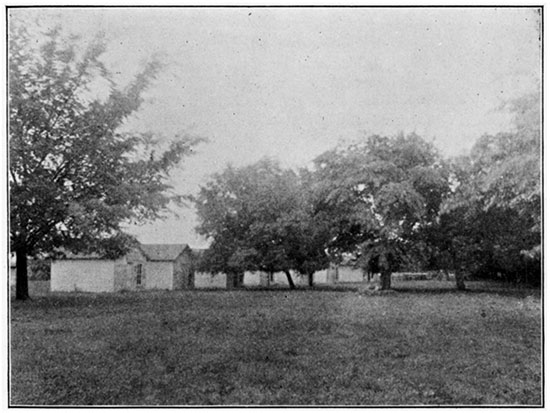
Plate 30--Bath-house and Pavilion, Arrington Springs.
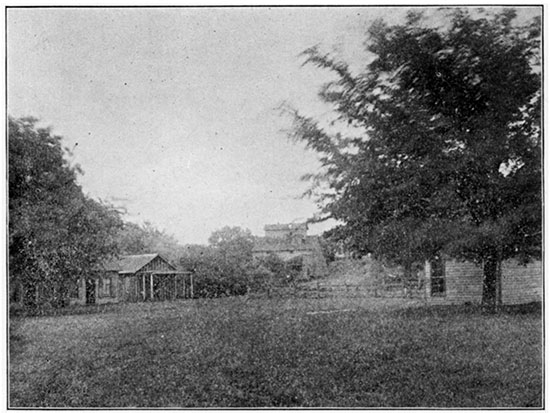
| Arrington No. 2 | |
|---|---|
| Ions | Grams per liter |
| Sodium (Na) | .0479 |
| Ammonia (NH.) | trace |
| Calcium (Ca) | .0454 |
| Magnesium (Mg) | .0156 |
| Iron (Fe) | .0161 |
| Chlorin (Cl) | .0224 |
| Silicic acid ion (SiO3) | .0204 |
Hypothetically combined as follows:
| Grams per liter |
Grains per gallon |
|
|---|---|---|
| Sodium chlorid (NaCl) | .0370 | 2.164 |
| Sodium bicarbonate (NaHCO3) | .0965 | 5.637 |
| Calcium bicarbonate (CaH2(CO3)2) | .1834 | 10.728 |
| Magnesium bicarbonate (MgH2(CO3)2) | .0953 | 5.569 |
| Iron bicarbonate (FeH2(CO3)2) | .0528 | .3.084 |
| Silica (SiO2) | .0095 | .555 |
| Organic matter | .0161 | .911 |
| Ammonia | trace | trace |
| Totals | .4906 | 28.648 |
| Analysis by Juan H. Wright, M. D. | ||
| Arrington No. 3 | |
|---|---|
| Ions | Grams per liter |
| Sodium (Na) | .0136 |
| Potassium (K) | trace |
| Lithium (Li) | trace |
| Calcium (Ca) | .0240 |
| Magnesium (Mg) | .0622 |
| Iron (Fe) | .0399 |
| Chlorin (Cl) | .0350 |
| Iodin (I) | trace |
| Sulfuric acid ion (SO4) | .1802 |
| Silicic acid ion (SiO3) | .0116 |
Hypothetically combined as follows:
| Grams per liter |
Grains per gallon |
|
|---|---|---|
| Sodium chlorid (NaCl) | .0344 | 2.003 |
| Potassium iodid (KI) | trace | trace |
| Lithium (Li) | trace | trace |
| Calcium sulfate (CaSO4) | .0052 | .308 |
| Calcium bicarbonate (CaH2(CO3)2) | .0914 | 5.334 |
| Magnesium chlorid (MgCl2) | .0190 | 1.112 |
| Magnesium sulfate (MgSO4) | .2205 | 12.882 |
| Magnesium bicarbonate (MgH2(CO3)2) | .0611 | 3.571 |
| Iron bicarbonate (FeH2(CO3)2) | .1206 | 7.044 |
| Silica (SiO2) | .0092 | .541 |
| Totals | .5614 | 32.795 |
| Analysis by Juan H. Wright, M. D. | ||
Atchison Electric-light Well
This well is seventy-five feet deep. Iron deposits readily from this water, staining the drinking vessels.
| Well of the Atchison Electric-Light and Power Plant Grams per liter |
||||
|---|---|---|---|---|
| Ions | Radicals | |||
| Sodium (Na) | .0414 | Sodium oxid (Na2O) | .0558 | |
| Potassium (K) | .0114 | Potassium oxid (K2O) | .0137 | |
| Calcium (Ca) | .1141 | Calcium oxid (CaO) | .1596 | |
| Magnesium (Mg) | .0254 | Magnesium oxid (MgO) | .0423 | |
| Iron (Fe) | .0675 | Iron oxid (FeO) | .0867 | |
| Aluminum (Al) | .0300 | Aluminum oxid (Al2O3) | .0567 | |
| Chlorin (Cl) | .0560 | Chlorin (Cl) | .0560 | |
| Sulfuric acid ion (SO4) | .0881 | Sulfuric anhydrid (SO3) | .0734 | |
| Silicic acid ion (SiO3) | .0752 | Silica (SiO2) | .0594 | |
| Water (H2O) | .1098 | |||
| Carbonic anhydrid (CO2) | .5384 | |||
| Oxygen equivalent | .0126 | |||
| Total | 1.2392 | |||
Hypothetically combined as follows:
| Grams per liter |
Grains per gallon |
|
|---|---|---|
| Sodium chlorid (NaCl) | .0046 | .2687 |
| Sodium bicarbonate (NaHCO3) | .1445 | 8.4402 |
| Potassium bicarbonate (KCO3) | .0292 | 1.7056 |
| Calcium bicarbonate (CaH2(CO3)2) | .4617 | 26.9679 |
| Magnesium bicarbonate (MgH2(CO3)2) | .1544 | 9.0185 |
| Iron bicarbonate (FeH2(CO3)2) | .2142 | 12.5114 |
| Aluminum chlorid (AlCl3) | .0666 | 3.8901 |
| Aluminum sulfate (Al2(SO4)3) | .1046 | 6.1097 |
| Silica (SiO2) | .0594 | 3.4695 |
| Totals | 1.2392 | 72.3816 |
| Temperature 13.3° C. (56° F.) Analysis by E. B. Knerr. |
||
McDuff's Spring, Atchison
There is a spring on the farm of Mr. Peter McDuff, four and a half miles northwest of Atchison. It is situated on the north side of a ravine, where the general trend of the land is toward the east. The water issues with a pretty strong flow and gives a slight. deposit of iron oxid along the course of the stream. There is no odor of hydrogen sulfid , but a careful chemical test of the freshly-drawn water shows small quantities of this gas. In the vicinity are some very excellent and abundant springs of clear, cold, fresh water. The analysis is as follows:
| McDuff's Spring Grams per liter |
||||
|---|---|---|---|---|
| Ions | Radicals | |||
| Sodium (Na) | .0202 | Sodium oxid (Na2O) | .0272 | |
| Potassium (K) | .0168 | Potassium oxid (K2O) | .0202 | |
| Calcium (Ca) | .0840 | Calcium oxid (CaO) | .1176 | |
| Magnesium (Mg) | .0131 | Magnesium oxid (MgO) | .0218 | |
| Iron (Fe) | .0168 | Iron oxid (FeO) | .0216 | |
| Aluminum (Al) | .0064 | Aluminum oxid (Al2O3) | .0120 | |
| Chlorin (Cl) | .0240 | Chlorin (Cl) | .0240 | |
| Sulfur (S) | .0109 | Sulfuric anhydrid (SO3) | .0151 | |
| Sulfuric acid ion (SO4) | .0181 | Hydrogen sulfid (H2S) | .0116 | |
| Silicic acid ion (SiO3) | .0442 | Silica (SiO2) | .0350 | |
| Water (H2O) | .0615 | |||
| Carbonic anhydrid (CO2) | .3018 | |||
| Oxygen equivalent | .0054 | |||
| Total | .6640 | |||
Hypothetically combined as follows:
| Grams per liter |
Grains per gallon |
|
|---|---|---|
| Sodium chlorid (NaCl) | .0200 | 1.1666 |
| Sodium bicarbonate (NaHCO3) | .0452 | 2.6365 |
| Potassium bicarbonate (KCO3) | .0430 | 2.5080 |
| Calcium bicarbonate (CaH2(CO3)2) | .3401 | 19.8400 |
| Magnesium bicarbonate (MgH2(CO3)2) | .0796 | 4.6430 |
| Iron bicarbonate (FeH2(CO3)2) | .0533 | 3.1090 |
| Aluminum chlorid (AlCl3) | .0148 | .8633 |
| Aluminum sulfate (Al2(SO4)3) | .0214 | 1.2430 |
| Silica (SiO2) | .0350 | 2.0415 |
| Hydrogen sulfid (H2S) | .0116 | .6766 |
| Totals | .6640 | 38.7275 |
| Hydrogen-sulfid gas, trace Specific gravity, 1.00085 Temperature 13.8° C. (57° F.) Analysis by E. B. Knerr. |
||
Forest Lake, Bonner Springs
Between Bonner Springs and Edwardsville, on the Union Pacific railway, about two miles below the former station, a small stream runs into the Kaw river from the north. Many years ago a dam was thrown across this stream, thus forming a pond about forty acres in extent, which now has the appearance of a natural lake, as the embankment is overgrown with grass and the banks are well wooded. This lake, known as "Forest Lake," is the property of J. W. McDanield, of Bonner Springs. On the west side the hill is somewhat precipitous and rocky, and from its summit there is a very extensive view to the east and southwest along the valley of the Kaw. The lake is used for harvesting ice in the winter, and, as it is well stocked with fish, it has become a favorite camping and fishing resort.
Improvements
Pavilions, a dancing platform, a commodious bath-house and landing-place have been erected in the grove on the west side of the lake. There are several wells or springs on the borders of the lake from which the water is drawn by means of ordinary suction-pumps. The water is clear when first drawn. and has a strong taste of iron, and in some cases of hydrogen sulfid. After the water has stood for a short time, like most chalybeate waters, it loses its carbon-dioxid gas and becomes turbid. These waters in this respect do not differ from other iron springs of the Kansas river valley.
| Forest Lake Well Grams per liter |
||||
|---|---|---|---|---|
| Ions | Radicals | |||
| Sodium (Na) | .0103 | Sodium oxid (Na2O) | .0139 | |
| Calcium (Ca) | .2736 | Calcium oxid (CaO) | .3836 | |
| Magnesium (Mg) | .0740 | Magnesium oxid (MgO) | .1232 | |
| Iron (Fe) | .0187 | Iron oxid (FeO) | .0241 | |
| Chlorin (Cl) | .0159 | Chlorin (Cl) | .0159 | |
| Sulfuric acid ion (SO4) | .0600 | Sulfuric anhydrid (SO3) | .0500 | |
| Silicic acid ion (SiO3) | .2095 | Silica (SiO2) | .1656 | |
| Carbonic anhydrid (CO2) | .7761 | |||
| Water (H2O) | .1703 | |||
| Oxygen equivalent | .0043 | |||
| Organic matter | trace | |||
| Total | 1.7684 | |||
Hypothetically combined as follows:
| Grams per liter |
Grains per gallon |
|
|---|---|---|
| Sodium chlorid (NaCl) | .0262 | 1.528 |
| Calcium sulfate (CaSO4) | .0585 | 3.411 |
| Calcium bicarbonate (CaH2(CO3)2) | 1.0084 | 58.808 |
| Magnesium bicarbonate (MgH2(CO3)2) | .4496 | 26.220 |
| Iron bicarbonate (FeH2(CO3)2) | .0601 | 3.505 |
| Silica (SiO2) | .1656 | 9.657 |
| Organic matter | trace | trace |
| Totals | 1.7684 | 103.129 |
| Free carbon, dioxid trace Free hydrogen sulfid, trace Analysis by E. H. S. Bailey and D. F. McFarland |
||
Plate 31--View on Forest Lake, Bonner Springs.
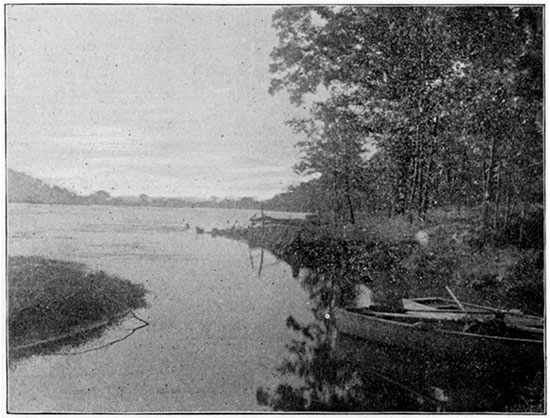
Plate 31--Parkhurst's Iron Spring, Independence.
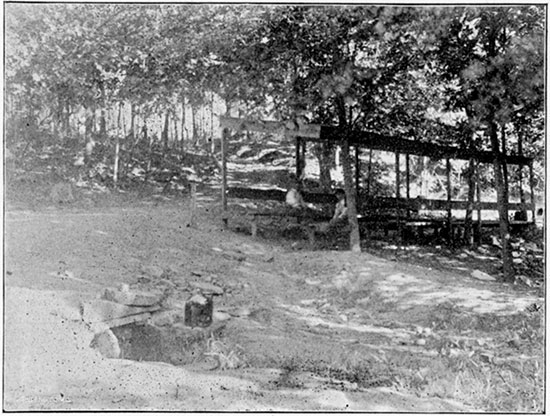
Forest Lake Iron Spring, Bonner Springs
A short distance west of the lake, just below the drive which runs to the lake, and near the dwelling occupied by the keeper, is another of the numerous iron springs of this vicinity. It is walled up and enclosed, and the water that escapes below is of the peculiar reddish color so commonly observed where iron and certain alges abound in the waters. The taste of the water is agreeable, with perhaps less iron and sulfur than that of the well previously noticed.
| Forest Lake Iron Spring Grams per liter |
||||
|---|---|---|---|---|
| Ions | Radicals | |||
| Sodium (Na) | .0010 | Sodium oxid (Na2O) | .0014 | |
| Calcium (Ca) | .1804 | Calcium oxid (CaO) | .2526 | |
| Magnesium (Mg) | .0241 | Magnesium oxid (MgO) | .0404 | |
| Iron (Fe) | .0283 | Iron oxid (FeO) | .0364 | |
| Chlorin (Cl) | .0016 | Chlorin (Cl) | .0016 | |
| Sulfuric acid ion (SO4) | .0252 | Sulfuric anhydrid (SO3) | .0212 | |
| Silicic acid ion (SiO3) | .0729 | Silica (SiO2) | .0575 | |
| Carbonic anhydrid (CO2) | .5073 | |||
| Water (H2O) | .1031 | |||
| Oxygen equivalent | .0003 | |||
| Total | 1.0212 | |||
Hypothetically combined as follows:
| Grams per liter |
Grains per gallon |
|
|---|---|---|
| Sodium chlorid (NaCl) | .0026 | .152 |
| Calcium sulfate (CaSO4) | .0360 | 2.104 |
| Calcium bicarbonate (CaH2(CO3)2) | .6878 | 40.181 |
| Magnesium bicarbonate (MgH2(CO3)2) | .1473 | 8.501 |
| Iron bicarbonate (FeH2(CO3)2) | .0900 | 5.263 |
| Silica (SiO2) | .0575 | 3.369 |
| Totals | 1.0212 | 59.570 |
| Temperature, 13.8° C. (57° F.) Analysis by E. H. S. Bailey and D. F. McFarland. |
||
Bonner Springs
Some of the springs in the park, referred to in chapter XIII, are chalybeate in character, as the following analyses show (Bull. U. S. Geol. Surv. No. 32): 77
| Bonner Spring No. 4 | |
|---|---|
| Ions | Grams per liter |
| Calcium (Ca) | .0802 |
| Magnesium (Mg) | .0096 |
| Iron (Fe) | .0546 |
| Chlorid (Cl) | trace |
| Phosphoric acid ion (PO4) | trace |
Hypothetically combined as follows:
| Grams per liter |
Grains per gallon |
|
|---|---|---|
| Calcium chlorid (CaCl2) | trace | trace |
| Calcium bicarbonate (CaH2(CO3)2) | .3243 | 18.942 |
| Magnesium bicarbonate (MgH2(CO3)2) | .0584 | 3.414 |
| Iron bicarbonate (FeH2(CO3)2) | .1735 | 10.135 |
| Phosphoric acid | trace | trace |
| Organic matter | trace | trace |
| Totals | .5562 | 32.491 |
| Analysis by Wm. Jones, M. D. | ||
| Bonner Spring No. 5 | |
|---|---|
| Ions | Grams per liter |
| Calcium (Ca) | .0936 |
| Magnesium (Mg) | .0114 |
| Iron (Fe) | .0410 |
| Chlorin (Cl) | trace |
| Sulfuric acid ion (SO4) | .0042 |
| Phosphoric acid ion (PO4) | trace |
Hypothetically combined as follows:
| Grams per liter |
Grains per gallon |
|
|---|---|---|
| Calcium chlorid (CaCl2) | trace | trace |
| Calcium sulfate (CaSO4) | .0059 | .344 |
| Calcium bicarbonate (CaH2(CO3)2) | .3720 | 21.730 |
| Magnesium bicarbonate (MgH2(CO3)2) | .0696 | 4.065 |
| Iron bicarbonate (FeH2(CO3)2) | .1302 | 7.603 |
| Phosphoric acid ion (PO4) | trace | trace |
| Organic matter | trace | trace |
| Totals | .5777 | 33.742 |
| Analysis by Wm. Jones, M. D. | ||
| Bonner Spring No. 6 | |
|---|---|
| Ions | Grams per liter |
| Calcium (Ca) | .0578 |
| Magnesium (Mg) | .0254 |
| Iron (Fe) | .0478 |
| Chlorin (Cl) | trace |
| Sulfuric acid ion (SO4) | .0073 |
| Phosphoric acid ion (PO4) | trace |
Hypothetically combined as follows:
| Grams per liter |
Grains per gallon |
|
|---|---|---|
| Calcium chlorid (CaCl2) | trace | trace |
| Calcium sulfate (CaSO4) | .0103 | .605 |
| Calcium bicarbonate (CaH2(CO3)2) | .2214 | 12.929 |
| Magnesium bicarbonate (MgH2(CO3)2) | .1570 | 9.172 |
| Iron bicarbonate (FeH2(CO3)2) | .1519 | 8.870 |
| Phosphoric acid | trace | trace |
| Organic matter | small amt. | small amt. |
| Totals | .5406 | 31.576 |
| Analysis by Wm. Jones, M. D. | ||
Coyville Ferro-manganese Well
About five miles southwest of Coyville, Wilson county, on the farm of Jacob Killion, is a bored well. The attention of the owner was attracted to the character of the water because an "oil" rose on the top after it had stood for a short time. Upon examination in the laboratory, this phenomenon was found to be due to the presence in the water of 'iron, and also a larger quantity of manganese than is usually found in natural waters. Coyville is on a branch of the Atchison, Topeka & Santa Fe railroad.
| Coyville Ferro-Manganese Water, Wilson County Grams per liter |
||||
|---|---|---|---|---|
| Ions | Radicals | |||
| Sodium (Na) | .0260 | Sodium oxid (Na2O) | .0342 | |
| Calcium (Ca) | .0168 | Calcium oxid (CaO) | .0235 | |
| Magnesium (Mg) | .0077 | Magnesium oxid (MgO) | .0128 | |
| Iron (Fe) | .0117 | Iron oxid (FeO) | .0151 | |
| Manganese (Mn) | .0198 | Manganese oxid (MnO) | .0254 | |
| Chlorin (Cl) | .0390 | Chlorin (Cl) | .0390 | |
| Silicic acid ion (SiO3) | .0304 | Silicic anhydrid (SiO2) | .0240 | |
| Carbonic anhydrid (CO2) | .1151 | |||
| Water (H2O) | .0235 | |||
| Oxygen equivalent | .0088 | |||
| Total | .3038 | |||
Hypothetically combined as follows:
| Grams per liter |
Grains per gallon |
|
|---|---|---|
| Sodium chlorid (NaCl) | .0643 | 3.756 |
| Calcium bicarbonate (CaH2(CO3)2) | .0680 | 3.972 |
| Manganese bicarbonate (MgH2(CO3)2) | .0468 | 2.734 |
| Iron bicarbonate (FeH2(CO3)2) | .0374 | 2.184 |
| Magnesium bicarbonate (MgH2(CO3)2) | .0633 | 3.697 |
| Silica (SiO2) | .0240 | 1.401 |
| Totals | .3038 | 17.744 |
| Partial analysis by E. H. S. Bailey and F. B. Porter. | ||
Parkhurst Spring, Independence
This spring is situated on the right bank of the Verdigris river, about a mile and a half northeast of the city of Independence. The river is beautifully shaded at this point, and a footpath leads from the spring to the bank of the river, perhaps fifty feet below. In this vicinity the Verdigris flows over rocks and shallows, and below the city (see cut) its course is turned due east by high, rocky banks. Just east of Independence the water is so deep that it furnishes ample water for a small steamboat and other light craft.
Improvements
In 1897 a road was constructed from the highway near the residence of Mr. Parkhurst, the owner of this spring, and a small pavilion was erected for the benefit of picnic parties. Beyond this no improvements have been made in the property.
Plate 32--Looking up the Verdigris, Independence.
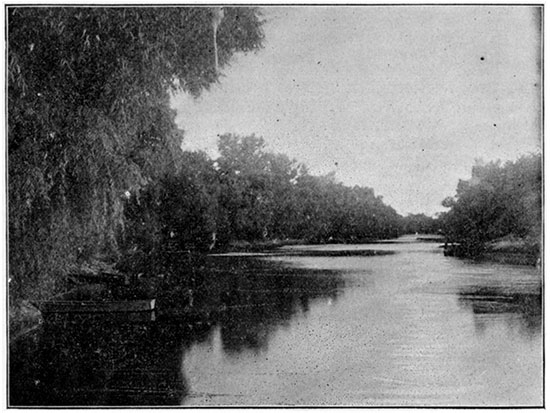
Plate 32--Louisville Springs.
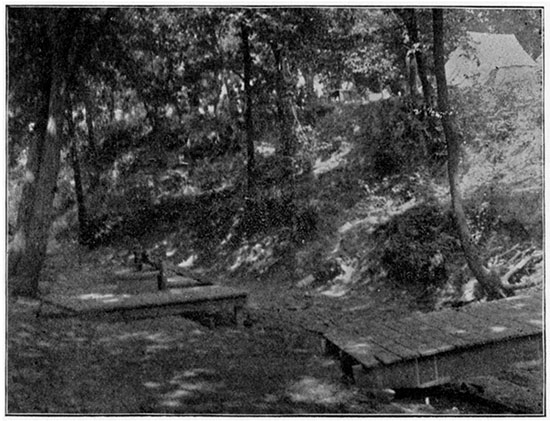
The spring flows from beneath a sandstone rock, and the water deposits much iron after it comes in contact with the air. The flow of the spring in the dryest weather is about sixty gallons per hour.
| Parkhurst Spring Grams per liter |
||||
|---|---|---|---|---|
| Ions | Radicals | |||
| Sodium (Na) | .0725 | Sodium oxid (Na2O) | .0955 | |
| Calcium (Ca) | .3735 | Calcium oxid (CaO) | .5231 | |
| Magnesium (Mg) | .1668 | Magnesium oxid (MgO) | .2784 | |
| Manganese (Mn) | .0018 | Manganese oxid (MnO) | .0021 | |
| Iron (Fe) | .0101 | Iron oxid (FeO) | .1325 | |
| Sulfuric acid ion (SO4) | 19.9545 | Sulfuric anhydrid (SO3) | 1.6718 | |
| Silicic acid ion (SiO3) | .0501 | Carbonic anhydrid (CO2) | .1716 | |
| Hydrogen sulfid (H2S) | .0014 | |||
| Silica (SiO2) | .0393 | |||
| Total | 2.9157 | |||
Hypothetically combined as follows:
| Grams per liter |
Grains per gallon |
|
|---|---|---|
| Sodium sulfate (Na2SO4) | .2187 | 12.774 |
| Calcium sulfate (CaSO4) | 1.5148 | 88.479 |
| Magnesium sulfate (MgSO4) | .8352 | 48.784 |
| Manganese bicarbonate (MgH2(CO3)2) | .0046 | .271 |
| Iron bicarbonate (FeH2(CO3)2) | .2952 | 17.244 |
| Silica (SiO2) | .0393 | 2.299 |
| Carbonic anhydrid (CO2) | .0063 | .373 |
| Hydrogen sulfid (H2S) | .0014 | .083 |
| Chlorin, potassium, and lithium | traces | traces |
| Totals | 2.9157 | 170.307 |
| Analysis by Paul Schweitzer. | ||
La Cygne Iron Spring
This spring is situated on the west bank of the Marais des Cygnes, near La Cygne, on the property of Mr. Cheagor. The spring is not large, although it seems to be a good chalybeate water. The total solids in the water are 31.326 grains, of which 3.5 grains are ferrous carbonate. There is also a considerable quantity of calcium carbonate and magnesium carbonate, with a small quantity of calcium sulfate, sodium chlorid, and manganese carbonate.
Clarus Spring, Batesville, Woodson County
This spring is situated on the Fort Scott & Wichita rail way, nine miles west of Yates Center. The water comes from beneath a thick limestone ledge. From the situation of the spring, it is probable that there is no opportunity for the water to become in any way contaminated by organic matter. The water, as will be seen by the analysis, belongs to that class of pure waters which are recommended by physicians on account of the fact that they contain so small a quantity of mineral salts. For some time this water was kept on tap at one of the drug-stores in Topeka.
Improvements
This spring is walled up and cemented, and a small springhouse has been built over it. The flow is about forty gallons per hour. The analysis is given in chapter XVIII.
Lawrence City Water, Douglas County
The water supplied to the city of Lawrence is practically a chalybeate water. It is obtained from a large well dug in the sand a short distance west of the river, and from points that have been driven into the soil in the vicinity. The water, after it is pumped, is aerated by flowing from the top of a pipe several feet into a reservoir, and it is then allowed to stand in settling basins for some time. This treatment, however, does not fully remove the iron, for, soon after the water is drawn from the service-pipes, it loses its carbon-dioxid gas, becomes partially oxidized, and deposits a yellowish sediment of ferric hydroxid. This water is of entirely different composition from the river water, as repeated analyses have shown. Waters of this character are common in the bottoms of the Kansas and Missouri river valleys, and also in various localities in the great Mississippi basin, as has been noticed by several chemists. The sample drawn from the service-pipes does not show the full amount of iron found in the well.
| Lawrence City Water Supply Water from tap at chemistry building December 20, 1901 Grams per liter |
||||
|---|---|---|---|---|
| Ions | Radicals | |||
| Sodium (Na) | .0736 | Sodium oxid (Na2O) | .0993 | |
| Calcium (Ca) | .1256 | Calcium oxid (CaO) | .1759 | |
| Magnesium (Mg) | .0259 | Magnesium oxid (MgO) | .0433 | |
| Iron (Fe) | .0098 | Iron oxid (FeO) | .0126 | |
| Chlorin (Cl) | .0920 | Chlorin (Cl) | .0920 | |
| Sulfuric acid ion (SO4) | .1063 | Sulfuric anhydrid (SO3) | .0902 | |
| Silicic acid ion (SiO3) | .0555 | Silicic anhydrid (SiO2) | .0446 | |
| Carbonic anhydrid (CO2) | .3145 | |||
| Water (H2O) | .0641 | |||
| Oxygen equivalent | .0207 | |||
| Totals | .9158 | |||
Hypothetically combined as follows:
| Grams per liter |
Grains per gallon |
|
|---|---|---|
| Sodium chlorid (NaCl) | .1518 | 8.861 |
| Sodium sulfate (Na2SO4) | .0428 | 2.501 |
| Calcium sulfate (CaSO4) | .1123 | 6.551 |
| Calcium bicarbonate (CaH2(CO3)2) | .3750 | 21.902 |
| Magnesium bicarbonate (MgH2(CO3)2) | .1582 | 9.241 |
| Iron bicarbonate (FeH2(CO3)2) | .0311 | *1.830 |
| Silica (SiO2) | .0446 | 2.605 |
| Totals | .9158 | 53.491 |
| Analysis by E. Bartow and J. S. Worley. | ||
| * Analyses of water from the reservoir direct have shown considerably over two grains. |
||
Plate 33--Suspension Bridge, Louisville.
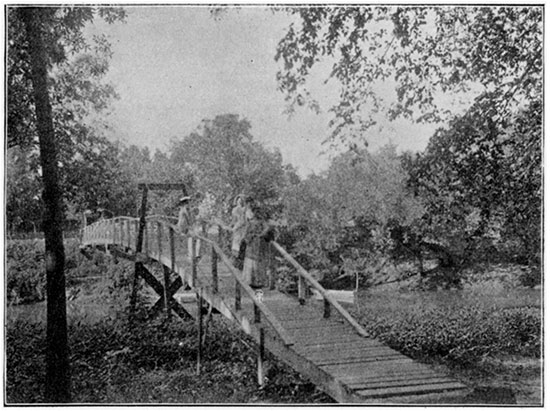
Plate 33--Bathing in Rock Creek, Louisville Springs.
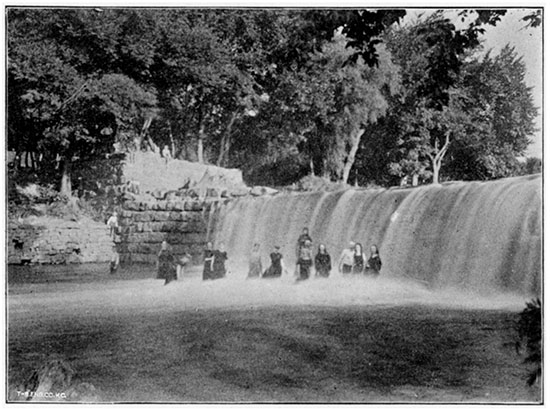
Louisville Springs
In Pottawatomie county, three miles north of Wamego, are situated the Louisville mineral springs. These are not far from Rock creek, a picturesque stream whose banks are well wooded. Wamego is on the main line of the Union Pacific railroad.
Improvements
A park, which is the property of R. M. Chilcott, is connected. with the village by a suspension foot bridge over Rock creek. Just below this bridge a dam has been thrown across the stream, and the swift water below the dam, at a ford on the old Pike's Peak trail, has washed away the soil and left bare the level limestone rock over a large area. This same stratum of rock that is here exposed extends northwest under the park and springs. On account of the level, smooth bottom in the pool below the dam, this pool is a favorite bathing place, especially when the water in the stream is high. Above the dam the slack water, which extends up about five miles, affords excellent boating and fishing facilities.
By sinking over the spring a tile twenty-four inches in diameter down to bed-rock, the spring-water has been made more accessible, and can be raised to a platform above by an ordinary pump. Although the water when first drawn is perfectly clear and transparent, in a short time it becomes yellow in color and very turbid. Boiling the water also causes a heavy deposit. The taste of the water is somewhat astringent, and occasionally it has a slight odor of hydrogen sulfid when it is freshly drawn. The water when evaporated has a somewhat alkaline reaction.
The analysis shows that the water is chalybeate, and also belongs to the class known as alkaline waters. From a medicinal point of view, its most important ingredients are magnesium bicarbonate, iron bicarbonate, and sodium sulfate. This water has the advantage of containing sodium salts not mixed with a large excess of salt, as is the case with many magnesium waters. On account of the presence of iron bicarbonate in the water, it is not adapted to shipping without being first carbonated. There are other chalybeate springs in this park the waters of which have not been analyzed. A few rods below the ford, on the right bank of the stream, there is a spring of extremely pure water flowing from beneath the limestone rock. Like some other pure waters that have been found in this state, it would probably be valuable in the treatment of diseases where an abundance of soft water is required.
| Louisville Spring (Kans. Univ. Quart., vol. VI, pp. 117-119) Grams per liter |
||||
|---|---|---|---|---|
| Ions | Radicals | |||
| Potassium (K) | .0043 | Potassium oxid (K2O) | .0052 | |
| Sodium (Na) | .0597 | Sodium oxid (Na2O) | .0805 | |
| Calcium (Ca) | .2709 | Calcium oxid (CaO) | .3817 | |
| Magnesium (Mg) | .0558 | Magnesium oxid (MgO) | .0932 | |
| Iron (Fe) | .0198 | Iron oxid (FeO) | .0255 | |
| Chlorin (Cl) | .0385 | Chlorin (Cl) | .0385 | |
| Sulfuric acid ion (SO4) | .1544 | Sulfuric anhydrid (SO3) | .1389 | |
| Nitric acid ion (NO3) | trace | Nitric anhydrid (N2O5) | trace | |
| Silicic acid ion (SiO3) | .0587 | Silica (SiO2) | .0464 | |
| Water (H2O) | .1558 | |||
| Carbonic anhydrid (CO2) | .7632 | |||
| Oxygen equivalent | .0090 | |||
| Total | 1.7199 | |||
Hypothetically combined as follows:
| Grams per liter |
Grains per gallon |
|
|---|---|---|
| Sodium chlorid (NaCl) | .0636 | 3.7148 |
| Sodium nitrate (NaNO3) | trace | trace |
| Sodium carbonate (NaHCO3) | .0193 | 1.1273 |
| Sodium sulfate (Na2SO4) | .0996 | 5.8176 |
| Potassium sulfate (K2SO4) | .0096 | .5607 |
| Calcium sulfate (CaSO4) | .1324 | 7.7334 |
| Calcium bicarbonate (CaH2(CO3)2) | .9465 | 55.2855 |
| Magnesium bicarbonate (MgH2(CO3)2) | .3393 | 19.8185 |
| Iron bicarbonate (FeH2(CO3)2) | .0632 | 3.6915 |
| Silica (SiO2) | .0464 | 2.7102 |
| Totals | 1.7199 | 100.4593 |
| Temperature, 13.3° C. (56° F.) Analysis by E. H. S. Bailey. |
||
Plate 34--The Ford, Louisville Springs.
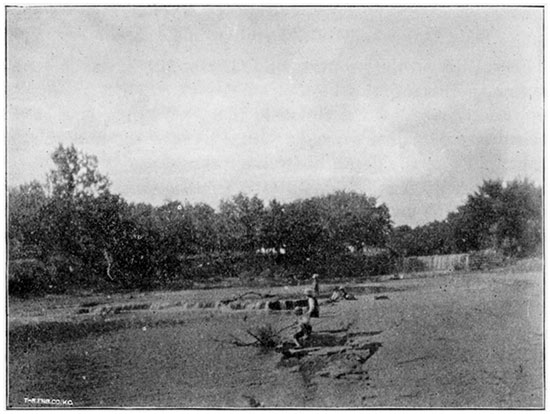
Plate 34--Topeka Mineral Wells.
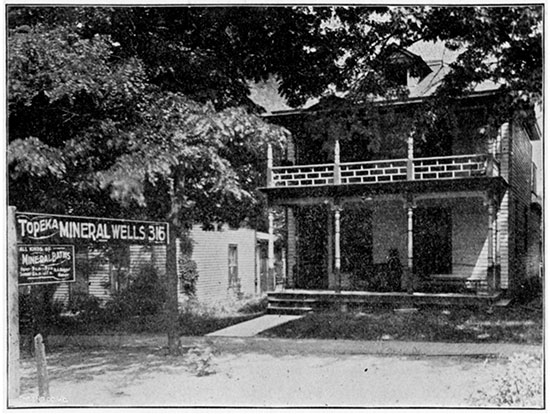
Mahaska Well, Washington County
This well is on the property of J. L. Summers, on the bank of a ravine, bordering the high prairie. The well is twenty feet deep, and is dug down to the solid rock, When this rock was reached it was drilled through with a hand drill, and the well filled rapidly to the depth of twelve feet.
This is a sulfate water containing small quantities of carbonates of lime and magnesia. It is slightly astringent in taste, on account of the iron that is present. One liter, on evaporation, leaves 159.27 grains of mineral matter, so the water contains a considerable quantity of sulfates. When first drawn the water is clear, but soon becomes yellow and turbid from the precipitation of iron. On this account the use of the water for household purposes has been abandoned, although it is still used for watering stock.
Muscotah Artesian Wells, Atchison County
(Trans. Kans. Acad. Sci., vol. XVII, pp. 53, 54.
by E. B. Knerr
"Along the base of the east bluff of the Grasshopper valley, about one and a half miles south of Muscotah, on the Central Branch Missouri Pacific railroad, there is a series of interesting. low ; marshy mounds. The mounded area on the farm of Mr. H. M. Rice is about one hundred rods long by fifteen rods wide, and the mounds are from five to eight feet high. About a quarter of a mile further south, on S. H. Hubbard's farm, is another mound, about fifteen yards wide, sixty yards long, and eight or ten feet high. Two miles further south, on J ames Miller's place, there are similar mounds. A swamp is usually low ground, but here the swampy ground is the highest.
"Early in September, 1900, Mr. Rice concluded that if he were to sink a pipe near one of these mounds, he would get an artesian flow of water. He bored a test hole with a two-inch auger, and at a depth of thirty-four feet struck a flow of water so strong as to force. up pebbles the size of a hickory-nut. A two-inch pipe was forced into the hole, and the water rose to overflow this when it stood fifteen feet above ground. The flow from this two-inch pipe is fifty gallons every fifty-five seconds. The water is as clear as crystal, very palatable, and cold. The water deposits a slight iron coating over the barrel into which it flows. Calcareous deposits are also found in places about the mound, indicating mineral properties for the water.
"The formation of mounds is explained by the water pressure carrying up sand and soil and depositing it at the surface. The mounds are covered by bulrushes, cat-tails and other usual swamp growth, which holds the soil, preventing its being washed down. The water springs from over the whole surface of the mound, and runs away in small streams. Thus the peculiar circumstance arises that the swamp is high ground and the firm soil is lower."
| Artesian Well, Muscotah Grams per liter |
||||
|---|---|---|---|---|
| Ions | Radicals | |||
| Sodium (Na) | .0181 | Sodium oxid (Na2O) | .0244 | |
| Potassium (K) | .0203 | Potassium oxid (K2O) | .0245 | |
| Calcium (Ca) | .1160 | Calcium oxid (CaO) | .1625 | |
| Magnesium (Mg) | .0214 | Magnesium oxid (MgO) | .0356 | |
| Iron (Fe) | .0360 | Iron oxid (FeO) | .0454 | |
| Chlorin (Cl) | .0176 | Chlorin (Cl) | .0176 | |
| Sulfuric acid ion (SO4) | .0660 | Sulfuric anhydrid (SO3) | .0550 | |
| Silicic acid ion (SiO3) | .0305 | Silicic anhydrid (SiO2) | .0280 | |
| Carbonic anhydrid (CO2) | .3644 | |||
| Water (H2O) | .0746 | |||
| Oxygen equivalent | .0040 | |||
| Total | .8280 | |||
Hypothetically combined as follows:
| Grams per liter |
Grains per gallon |
|
|---|---|---|
| Sodium chlorid (NaCl) | .0290 | 1.6907 |
| Sodium sulfate (Na2SO4) | .0206 | 1.2010 |
| Potassium sulfate (K2SO4) | .0453 | 2.6410 |
| Calcium bicarbonate (CaH2(CO3)2) | .4702 | 27.4126 |
| Magnesium sulfate (MgSO4) | .0339 | 1.9764 |
| Magnesium bicarbonate (MgH2(CO3)2) | .0887 | 5.1712 |
| Iron bicarbonate (FeH2(CO3)2) | .1123 | 6.5471 |
| Silica (SiO2) | .0280 | 1. 6324 |
| Totals | .8280 | 48.2724 |
| Temperature 13.3° C. (56° F.) Analysis by E. B. Knerr. |
||
Topeka Mineral Well
This well, which is in the rear of 316 Harrison street, was bored through thirty feet of soil and twenty-five feet of rock. The well above the rock is three feet in diameter and the pump is cemented to the opening in the rock.
Improvements
Improvements are a commodious bath hotel with a pumping plant, tanks, arrangements for heating the water, cooling rooms, etc. Special attention has been paid to giving steam and Russian baths. The water is all used commercially.
| Topeka Mineral Well (Mineral Waters of the United States, Crook, pp. 246, 247) |
|
|---|---|
| Ions | Grams per liter |
| Sodium (Na) | .2803 |
| Ammonium | .0070 |
| Calcium (Ca) | .0953 |
| Magnesium (Mg) | .100.3 |
| Iron (Fe) | .1514 |
| Aluminum (Al) | .0036 |
| Chlorin (Cl) | .3732 |
| Sulfuric acid ion (SO4) | .4385 |
| Silicic acid ion (SiO3) | .2230 |
| Phosphoric acid ion (PO4) | trace |
| Nitric acid ion (NO3) | .0244 |
Hypothetically combined as follows:
| Grams per liter |
Grains per gallon |
|
|---|---|---|
| Sodium sulfate (Na2SO4) | .3296 | 19.25 |
| Sodium nitrate (NaNO3) | .0332 | 1.94 |
| Sodium bicarbonate (NaHCO3) | .6109 | 35.68 |
| Ammonium sulfate (NH4)2SO4) | .0256 | 1.50 |
| Calcium bicarbonate (CaH2(CO3)2) | .3853 | 22.51 |
| Magnesium chlorid (MgCl2) | .2016 | 11.78 |
| Magnesium sulfate (MgSO4) | .2465 | 14.40 |
| Iron bicarbonate (FeH2(CO3)2) | .4811 | 28.10 |
| Alumina (Al2O3) | .0068 | .40 |
| Silica (SiO2) | .1765 | 10.30 |
| Organic matter | .0302 | 1.76 |
| Phosphoric acid ion (PO4) | trace | trace |
| Totals | 2.5273 | 147.62 |
| Temperature, 15° C. (59° F.) Analysis by Barnes and Sim. |
||
Capital Mineral Well, Topeka
This well is situated at 1018 Kansas avenue, in the thickly populated portion of the city. The well is seventy feet back from the street, on high land. It is 122 feet deep, the first twenty feet being bored through compact earth and clay, and the remaining 102 feet through rock and seams of earth. The water is supposed to come from a point 100 feet below the surface. It is sold to customers in the city of Topeka. The proprietor of the well is John W. Newbury.
| Capital Well Grams per liter |
||||
|---|---|---|---|---|
| Ions | Radicals | |||
| Sodium (Na) | .3608 | Sodium oxid (Na2O) | .4858 | |
| Calcium (Ca) | .1832 | Calcium oxid (CaO) | .2559 | |
| Magnesium (Mg) | .0713 | Magnesium oxid (MgO) | .1183 | |
| Iron (Fe) | .0865 | Iron oxid (FeO) | .1113 | |
| Chlorin (Cl) | .3200 | Chlorin (Cl) | .3200 | |
| Sulfuric acid ion (SO4) | .2224 | Sulfuric anhydrid (SO3) | .1710 | |
| Silicic acid ion (SiO3) | .3098 | Silica (SiO2) | .2400 | |
| Organic matter | trace | |||
| Carbonic anhydrid (CO2) | .8810 | |||
| Water (H2O) | .1640 | |||
| Oxygen equivalent | .0755 | |||
| Total | 2.6718 | |||
Hypothetically combined as follows:
| Grams per liter |
Grains per gallon |
|
|---|---|---|
| Sodium chlorid (NaCl) | .4997 | 29.1874 |
| Sodium sulfate (Na2SO4) | .3920 | 22.8967 |
| Calcium bicarbonate (CaH2(CO3)2) | .7400 | 43.2234 |
| Magnesium bicarbonate (MgH2(CO3)2) | .4320 | 25.2331 |
| Iron bicarbonate (FeH2(CO3)2) | .2751 | 16.0744 |
| Silica (SiO2) | .2400 | 14.0184 |
| Carbonic anhydrid (CO2) | .0930 | 5.4321 |
| Organic matter | trace | trace |
| Totals | 2.6718 | 156.0655 |
| Analysis by J. T. Lovewell | ||
Wetmore, Nemaha County
The Wetmore mineral springs, which have been known for over thirty years, are situated inside the city limits of Wetmore, not more than a quarter of a mile from the center of the town. There is one large spring here and several small ones. A building is being erected here for the bottling works and bathhouse by the Wetmore Springs Mineral Water Company, under the direction of Chas. S. Lochnane. There are good hotels in the town, as well as private boarding-houses. The analysis of the water was made several years ago. Wetmore is on the line of the Central Branch Missouri Pacific railroad, forty-three miles west of Atchison.
| Wetmore Mineral Springs, Spring No. 1 | |
|---|---|
| Ions | Grams per liter |
| Sodim (Na) | .0241 |
| Potassium (K) | .0582 |
| Calcium (Ca) | .0888 |
| Magnesium (Mg) | .0807 |
| Iron (Fe) | .0214 |
| Chlorin (Cl) | .0323 |
| Sulfuric acid ion (SO4) | .2201 |
| Silicic acid ion (SiOs) | .0289 |
| Phosphoric acid ion (PO4) | .0033 |
Hypothetically combined as follows:
| Grams per liter |
Grains per gallon |
|
|---|---|---|
| Sodium chlorid (NaCl) | .0445 | 2.600 |
| Sodium bicarbonate (NaHCO3) | .0201 | 1.172 |
| Potassium chlorid (KCl) | .0111 | .647 |
| Calcium sulfate (CaSO4) | .1272 | 7.440 |
| Calcium phosphate (Ca3(PO4)2) | .0070 | .409 |
| Calcium bicarbonate (CaH2(CO3)2) | .1978 | 11.534 |
| Magnesium sulfate (MgSO4) | .1614 | 9.433 |
| Magnesium bicarbonate (MgH2(CO3)2) | .2942 | 17.197 |
| Iron bicarbonate (FeH2(CO3)2) | .0682 | 3.986 |
| Silica (SiO2) | .0228 | 1.330 |
| Organic matter | .0281 | 1.640 |
| Totals | .9824 | 57.388 |
| Specific gravity, 1.0068 Temperature, 10° C. (50° F.) Analysis by Juan H. Wright, M. D. |
||
Comparison of Similar Waters
Excelsior Springs, Mo., Regent Spring
| Grains per gallon Analysis by Woodward and Robertson |
|
|---|---|
| Sodium chlorid | 2.230 |
| Potassium chlorid | .670 |
| Calcium bicarbonate | 28.867 |
| Magnesium chlorid | .420 |
| Magnesium bicarbonate | 3.754 |
| Magnesium sulfate | .350 |
| Ferrous bicarbonate | 3.438 |
| Manganese bicarbonate | .982 |
| Alumina | .297 |
| Silica | 1.116 |
| Oxygen | .1998 |
| Total | 42.124 |
Monroe County, Wisconsin, Spata Artesian Well
| Grains per gallon Analysis by J. M. Hirsch |
|
|---|---|
| Sodium chlorid | .112 |
| Sodium sulfate | 1.840 |
| Sodium carbonate | .120 |
| Sodium phosphate | .056 |
| Potassium sulfate | .528 |
| Lithium carbonate | .016 |
| Calcium chlorid | .504 |
| Calcium sulfate | .144 |
| Calcium carbonate | .232 |
| Magnesium carbonate | 1.992 |
| Strontium carbonate | .008 |
| Ferrous carbonate | 8.664 |
| Aluminum phosphate | .048 |
| Silica | .232 |
| Total | 14.496 |
Rock Enon Springs, Frederick County, Virginia, Copper Spring
| Grains per gallon Analysis by Gale and Mew |
|
|---|---|
| Sodium carbonate | 1.21 |
| Calcium sulfate | 3.56 |
| Calcium carbonate | 5.13 |
| Magnesium chlorid | 1.12 |
| Magnesium sulfate | 12.89 |
| Ferrous carbonate | 14.25 |
| Manganese carbonate | 1.05 |
| Alumina | .80 |
| Silica | .42 |
| Total | 40.43 |
Schwalbach, Germany, Stablbrunnen
| Grains per gallon Analysis by Fresenius |
|
|---|---|
| Sodium sulfate | .461 |
| Sodium bicarbonate | 1.347 |
| Potassium sulfate | .216 |
| Potassium chlorid | .391 |
| Calcium bicarbonate | 14.542 |
| Magnesium bicarbonate | 14.138 |
| Manganese bicarbonate | 1.196 |
| Ferrous bicarbonate | 5.445 |
| Silica | 1.869 |
| Total | 39.605 |
Marienbad, Germany, Ambrosius brunn
| Grains per gallon Analysis by Gintl |
|
|---|---|
| Sodium chlorid | .806 |
| Sodium sulfate | 18.189 |
| Sodium bicarbonate | 4.824 |
| Sodium nitrate | .041 |
| Potassium sulfate | 2.021 |
| Lithium carbonate | .041 |
| Calcium sulfate | 2.675 |
| Calcium bicarbonate | 17.534 |
| Magnesium chlorid | 1.466 |
| Magnesium bicarbonate | 16.863 |
| Iron bicarbonate | 9.737 |
| Manganese bicarbonate | .146 |
| Aluminous phosphate | .309 |
| Silica | 2.909 |
| Carbon dioxid (free) | 134.010 |
| Total | 211.571 |
There are some waters that contain larger amounts of iron than those just mentioned, but, on account of the presence in these waters of much sulfuric acid, the iron is usually considered to be combined as iron sulfate. Aluminum sulfate is very often present in large quantities in these waters, as they may be formed by the decomposition and oxidation of shale containing pyrite. The latter on being oxidized furnishes both the iron and the sulfate ion. The excess of the sulfate dissolves the alumina in the shale. The following may be considered as typical waters of this class, and are classified as chalybeate by many authors:
Bath Alum Springs, Virginia, No. 2
| Grains per gallon Analysis by W. H. Taylor |
|
|---|---|
| Sodium chlorid | .11 |
| Sodium sulfate | 1.13 |
| Potassium sulfate | .34 |
| Calcium sulfate | 1.71 |
| Magnesium sulfate | .46 |
| Iron persulfate | 26.78 |
| Manganese sulfate | .03 |
| Aluminum sulfate | 29.99 |
| Sulfuric acid | 2.88 |
| Silica | 1.95 |
| Total | 65.38 |
Brighton, England
| Grains per gallon Analysis by Marcet |
|
|---|---|
| Sodium chlorid | 12.241 |
| Calcium sulfate | 32.72 |
| Magnesium chlorid | 6.00 |
| Ferrous sulfate | 14.40 |
| Silica | 1.12 |
| Loss | 1.52 |
| Total | 68.00 |
| Carbon dioxid, 20 cubic inches. | |
A Comparison of Some of the Waters of the Iron Group
These waters are mainly carbonates, containing larger quantities of iron than usual. The other substances of importance are calcium and magnesium bicarbonates. The amount of iron bicarbonate in the different waters discussed is as follows:
| Grains per gallon | |
|---|---|
| Lawrence city supply | 1.830 |
| Coyville | 2.184 |
| Coyville, MnH2(CO3)2 | 3.697 |
| Arrington No. 2 | 3.084 |
| McDuff's spring | 3.109 |
| Forest Lake well | 3.505 |
| Louisville | 3.691 |
| Wetmore | 3.986 |
| Forest Lake spring | 5.263 |
| Arrington No. 1 | 5.484 |
| Muscotah | 6.547 |
| Arrington No. 3 | 7.044 |
| Bonner No. 5 | 7.603 |
| Bonner No. 6 | 8.870 |
| Bonner No. 4 | 10.135 |
| Atchison electric light | 12.511 |
| Capital | 16.074 |
| Parkhurst | 17.244 |
| Parkhurst, MnH2(CO3)2 | .271 |
| Regent, Excelsior Springs, Mo | 3.483 |
| Regent, Excelsior Springs, Mo., MnH2(CO3)2 | .982 |
| Schwalbach, Germany | 5.445 |
| Schwalbach, Germany, MnH2(CO3)2 | 1.196 |
| Sparta, Wis | 8.644 |
| Marienbad, Germany | 9.734 |
| Marienbad, MnH2(CO3)2 | .146 |
| Rock Enon, Va | 14.250 |
| Bath Alum, Va., (iron persulfate) | 26.78 |
| Brighton, England (ferrous sulfate) | 26.78 |
Prev Page--Waters of Kansas--Sulfid || Next Page--Waters of Kansas--Special
Kansas Geological Survey, Geology
Placed on web April 7, 2017; originally published 1902.
Comments to webadmin@kgs.ku.edu
The URL for this page is http://www.kgs.ku.edu/Publications/Bulletins/Vol7/18_iron.html